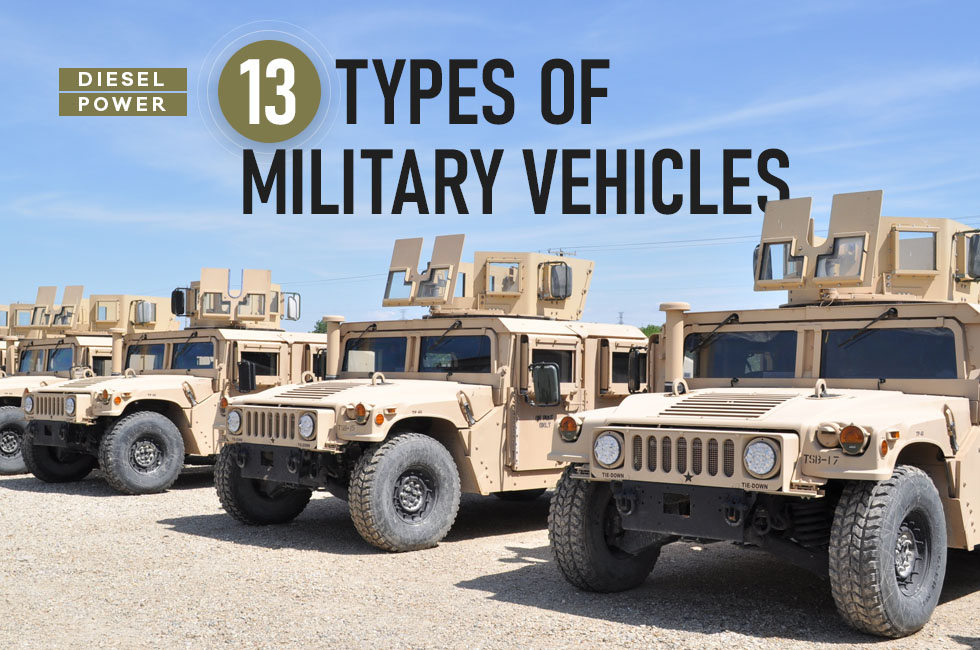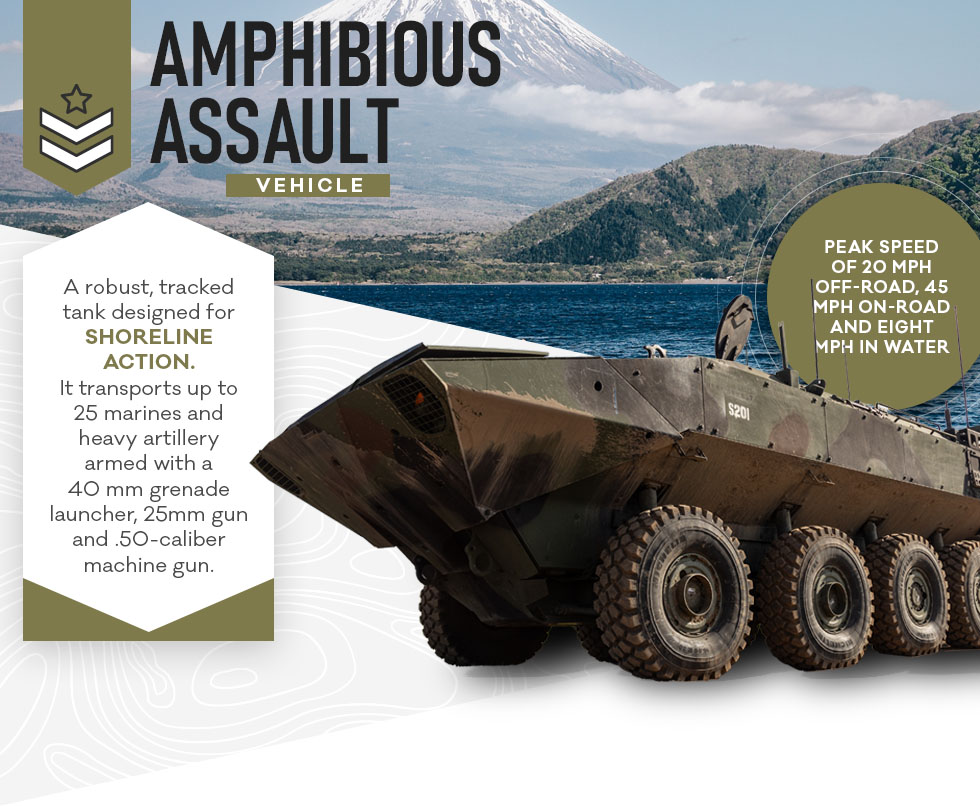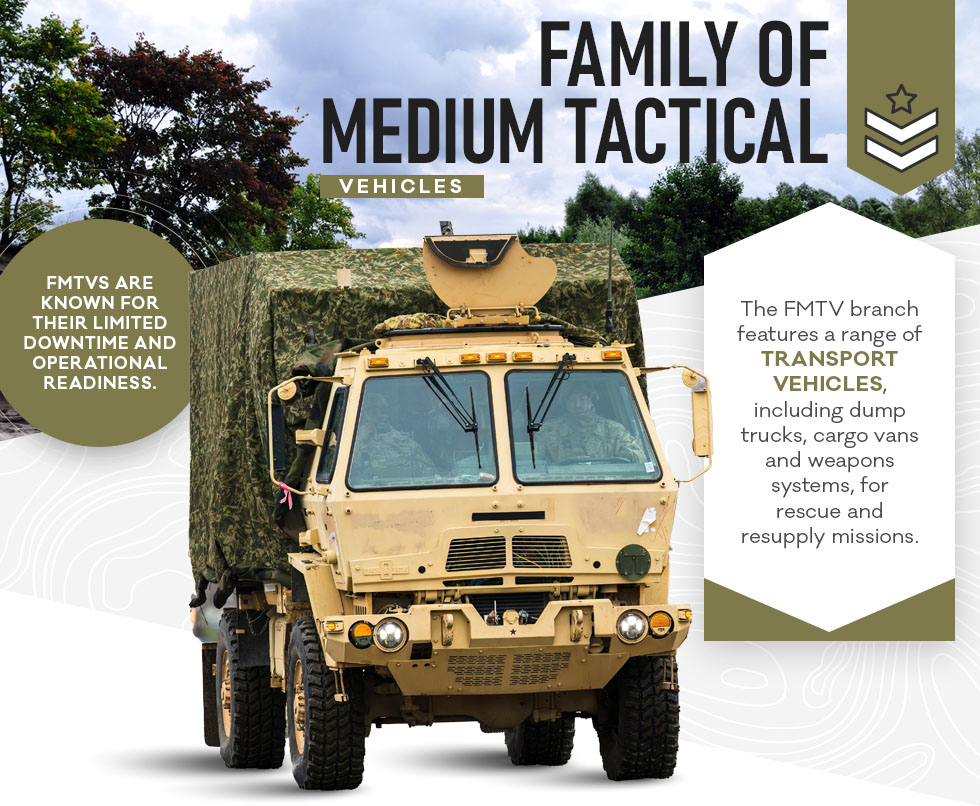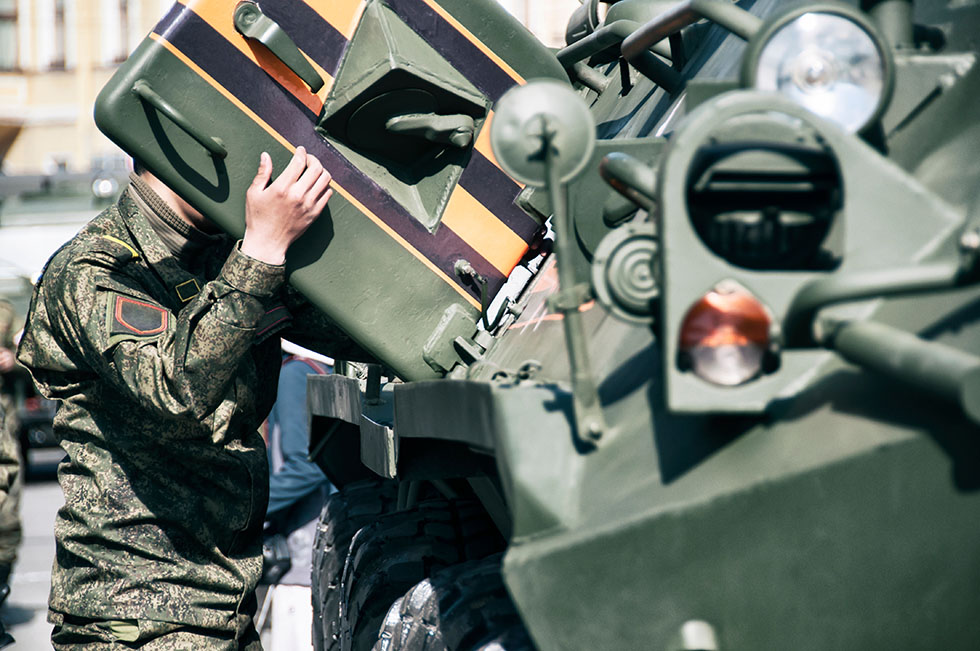Diesel Power: 13 Types of Military Vehicles
Aug 8th 2024

The U.S. wouldn’t have the military might it does today without diesel fuel, which packs more power into every molecule than gasoline to move thousands of pounds of tactical equipment with precision and force. Most tanks, armored cars, cougars, humvees and reconnaissance vehicles rely on this technology to get to the front, often through muddy bogs, rigid ravines and blown-out streets, while defending themselves against enemy combatants. Every vehicle needs robust fortifications to shield troops from attacks during transit, which requires torque and horsepower, and diesel is ideal for going off-road and heavy hauling. Learn what makes diesel products essential to military operations at home and abroad.
A Brief History of Military Vehicles
Diesel has been around since the late 1800s when the world’s automobiles were rolling off the assembly line. However, it didn’t make its way into military applications until 1916 when the Army chased “Pancho” Villa into the mountains of Mexico for raiding a border town on the U.S. southern border.
The unit drove several newly designed trucks and off-road vehicles — including a 1915 GMC Model 15, weighing around 1,500 lbs — some 400 miles over rugged terrain, but some never made it past the sand and mud. The mission may have failed to bring the perpetrator to justice, but it taught the Army the importance of using vehicles that withstand the elements.
Diesel soon eclipsed gas as the primary driver of military vehicles. What is diesel, and how does it compare to gas? It’s more efficient and stable than gasoline, which makes it safer to transport and use in unpredictable settings. The engine uses extreme heat and pressure to ignite the fuel-air mixture instead of a spark. Diesel vehicles also last longer than gas trucks, increasing reliability.
When the U.S. entered WWI in 1917, the upgraded GMC Model 16 became the country’s truck of choice. It had a 132-inch wheelbase, 35-inch tires, an engine with 30 max horsepower and a top speed of 25 mph. The military often used it as a field ambulance for soldiers on the front lines. By 1918, General Motors had devoted nearly 90% of its production line to building military vehicles.
The military’s love affair with the American automotive industry didn’t end there. Major players like GMC, Ford, Cummins, Caterpillar, Hercules and other specialty manufacturers continue to make equipment specifically for tactical use. Department of Defense officials list their technical requirements and have these companies propose custom builds for specific tasks.
Current Types of Military Vehicles

1. AAV7 Amphibious Assault Vehicle
A Marine Corps stable, the AAV7 is a robust, tracked tank designed for shoreline action. It transports up to 25 marines and heavy artillery armed with a 40 mm grenade launcher, 25mm gun and .50-caliber machine gun. It runs on a Detroit Diesel 8V-53T or Cummins VT 400 903, and it can travel up to 300 miles on land or 20 nautical miles with a peak speed of 20 mph off-road, 45 mph on-road and eight mph in water.
2. Amphibious Combat Vehicle (ACV)
The military is replacing tracked amphibious tanks with eight-wheeled amphibious combat vehicles because they are easier to maintain. In 2018, BAE won a contract worth $198 million to build the first 30 vehicles. The latest models weigh 35 tons and can fit up to 13 soldiers. The engine produces up to 690 horsepower with a range of 325 miles or 12 nautical miles. Future versions will have a 30mm cannon, a .50-caliber machine gun and a grenade launcher turret.
3. Cougar 6x6 MRAP
Nothing withstands a blow like the Cougar. They send up to eight troops with two operators into the harshest combat zones during medical, evacuation and reconnaissance missions. Recent skirmishes in Iraq and Afghanistan prove that they can survive landmine attacks and ambushes, which is why they’re known as Mine Resistant Ambush Protected. They often only need a few hours of repairs to return to the front after an attack and have a high survival rate to minimize losses.

4. Family of Medium Tactical Vehicles (FMTV)
The FMTV branch features a range of transport vehicles, including dump trucks, cargo vans and weapons systems, for rescue and resupply missions. The Caterpillar C7 6-cylinder heavy-duty diesel engine produces 330 or 275 max horsepower, depending on the configuration. With lives on the line, FMTVs are known for their limited downtime and operational readiness.
5. Heavy Expanded Mobility Tactical Truck (HEMTT)
Few machines can rival the towing power of the HEMTT from Oklahoma Defense, also known as the “Dragon Wagon.” It has powered military logistics since 1985 and has since been modified to increase efficiency and reliability. Over 13,000 are currently in operation, shipping supplies and arms around the globe. The A4 LHS model has a Caterpillar C15 diesel engine with an 11-ton payload. HEMTTs encompass a range of configurations to transport different types of goods. The M977 A2 hauls large replacement parts, the M978 is fitted with a 2,500-gallon tank for transporting fuel and the M985 A2 carries guided missiles, lifting 5,400 lbs.
6. High Mobility Multipurpose Wheeled Vehicle (HMMWV)
The HMMWV is a rugged, lightweight land cruiser powered by a V8 diesel 6.2-liter engine or a V8 turbocharged 6.5-liter diesel. Soldiers use them to transport commanders and weapons, often through hostile territory. They can travel up to 70 mph and have expert handling and off-road performance to dodge enemy fire. The latest model includes 15 configurations to make room for troops, weapons or medical equipment.

7. LAV-25 Light Armored Vehicle
Powered by the Detroit Diesel 6V53, the LAV-25 Light Armored Vehicle is an agile shooter designed to hit the enemy from any angle. It has a 25mm chain gun with 400 reserve rounds and an M240 7.62mm machine gun with 1,200 stored rounds. There’s room for six soldiers, and three crew members work the guns and controls.
8. Lightweight Tactical All Terrain Vehicle (LTATV)
The military uses LTATVs when it needs to get somewhere fast. They are militarized versions of utility-terrain vehicles, such as the Polaris MRZR and Kawasaki Teryx 750. They’re small enough to be transported in other vehicles and have a low profile for reconnaissance and battlefield surveillance. Most models can seat two and carry up to 500 pounds of gear. They have front differential locking, shoulder harnesses, rollover protection and infrared headlamp filters to increase visibility and driver safety.
9. M1117 Armored Security Vehicle (ASV)
The M1117 brings the heat during rescue, law and order and prisoner-of-war missions. It’s turreted and armed with two machine guns and a grenade launcher. The Cummins 6CTA8.3 engine can reach up to 63 mph and has a range of 440 miles. The exterior is heavily fortified with an enclosed turret to protect the shooter and ammunition.
10. M1126 Stryker Combat Vehicle
Named after Stuart S. Stryker, who served in World War II, and Robert F. Stryker, who served in Vietnam, the Stryker is a lightweight, mobile grenade launcher for hitting enemy combatants. Traveling up to 300 miles at 60 mph with a Caterpillar C7 diesel engine, they are armored to the teeth to protect the two operators inside from projectiles and rocket fire. The protected, remote-controlled weapon station keeps the crew at a safe distance.

11. M2/M3 Bradley Fighting Vehicle
Armed with a 25mm M242 chain gun, an anti-tank missile and a 7.62mm M240C machine gun, the Bradley Fighting Vehicle packs a punch in active war zones. It provides short and long-range firepower as the proximity of the threat advances or retreats. The Cummins VTA-903T diesel produces 500 horsepower with a peak speed of 41 mph.
12. M88A2 Hercules Recovery Vehicle
The M88A2 is a heavily armored, tracked tank used for support, recovery and assault missions. It carries a 0.50-caliber machine gun to keep enemies at bay and a 12-cylinder 1,050-horsepower diesel engine. The latest version has power-assisted braking, steering and winching to avoid landmines and save felled equipment.
13. Medium Tactical Vehicle Replacement MTVR
With an armored grille like something from a Mad Max movie, the MTVR traverses sandy, uneven terrain on six wheels, transporting gear and supplies like food and water. It can be fitted as a dump truck, cargo truck, tractor, wrecker or nine-ton winch. With 425 horsepower, the Caterpillar C-12 11.9-liter turbocharged diesel engine can haul up to seven tons off-road and 15 tons on-road.
Diesel Vehicle Maintenance
Like a well-oiled machine, the military monitors the performance of every vehicle with regularly scheduled inspection intervals to keep the fleet action-ready. Forces can’t afford to wait for these vehicles to break down. Preventative maintenance addresses potential issues before they manifest on the field. Any deviation could be a sign of problems starting to form. Every checkup includes monitoring fluid levels and testing them for contamination, inspecting parts for rust and decay, and a full operations test.
Shop All of Our Diesel PartsDiesel vehicles rapidly lose efficiency and power as the injector pump and fuel injectors age. The injector pump can collect rust if fuel sits in the tank too long, spreading debris throughout the fuel system. The injectors can clog with rust and carbon deposits, limiting how much fuel the engine can burn. A melted or broken nozzle also makes it harder for the fuel to burn, forcing the engine to consume more than usual. These problems increase the mpg rating, deplete precious supplies and delay start times, which could put lives at risk.
Mechanics should check for cloudy, discolored fuel; monitor fuel pressure; and replace the injector pump if the pressure remains low or the fuel appears contaminated. The pump sets the engine’s rhythm, delivering just enough fuel to reach the required RPM.
The fuel system relies on high-quality oil to pressurize the fuel before it’s injected into the combustion chamber. A lack of lubrication spreads rust and can cause the nozzle to stick or misfire. The military will install new diesel fuel injectors to restore efficiency and prevent false starts.
Overheating, especially in arid, sweltering conditions, accelerates mechanical degradation. High temperatures burn off fuel, oil and coolant before they reach their destination, reducing efficiency and putting excess pressure on metal parts. The exhaust gas recirculation cooler lowers the temperature of the exhaust recycled through the engine. Excess friction and a lack of coolant can cause the EGR cooler to leak. The engine will overheat if the exhaust doesn’t cool before it re-enters the combustion chamber.
Maintenance Safety

Making repairs can be just as dangerous as fighting on the front lines. Vehicle maintenance is one of the leading causes of injuries in the military. Workers can fall from the platform, get stuck between the vehicle and an obstacle, be struck by debris or get their fingers or legs caught in the gears.
The repair crew should lock out vehicles during repairs; work on platforms when possible; and secure doors, hatches and hoods with pins to prevent accidental closure. Everyone must wear personal protective equipment to protect their faces and hands from moving parts and hazardous chemicals. The work should be performed in a controlled, enclosed area away from potential obstacles.
The U.S. military is one of the world’s biggest diesel fuel users. The Department of Defense deploys and maintains an arsenal of vehicles designed for specific purposes. These tanks, trucks and ATVs are designed to go virtually anywhere under dangerous conditions. Each one needs regular fluid checks, service inspections and parts replacements to keep troops out of harm’s way and our country safe.
Image Credits
magnemizer/Shutterstock.com
A7880S/Shutterstock.com
Jackie Niam/Shutterstock.com
mr_bom/Shutterstock.com
Aqeela_Image/Shutterstock.com
Karolis Kavolelis/Shutterstock.com
Natalin*ka/Shutterstock.com
Leonard Zhukovsky/Shutterstock.com
VagrantDragon/Shutterstock.com
Anastassiia/Shutterstock.com
Karina Zelentsova/Shutterstock.com
Ryanzo W. Perez/Shutterstock.com
